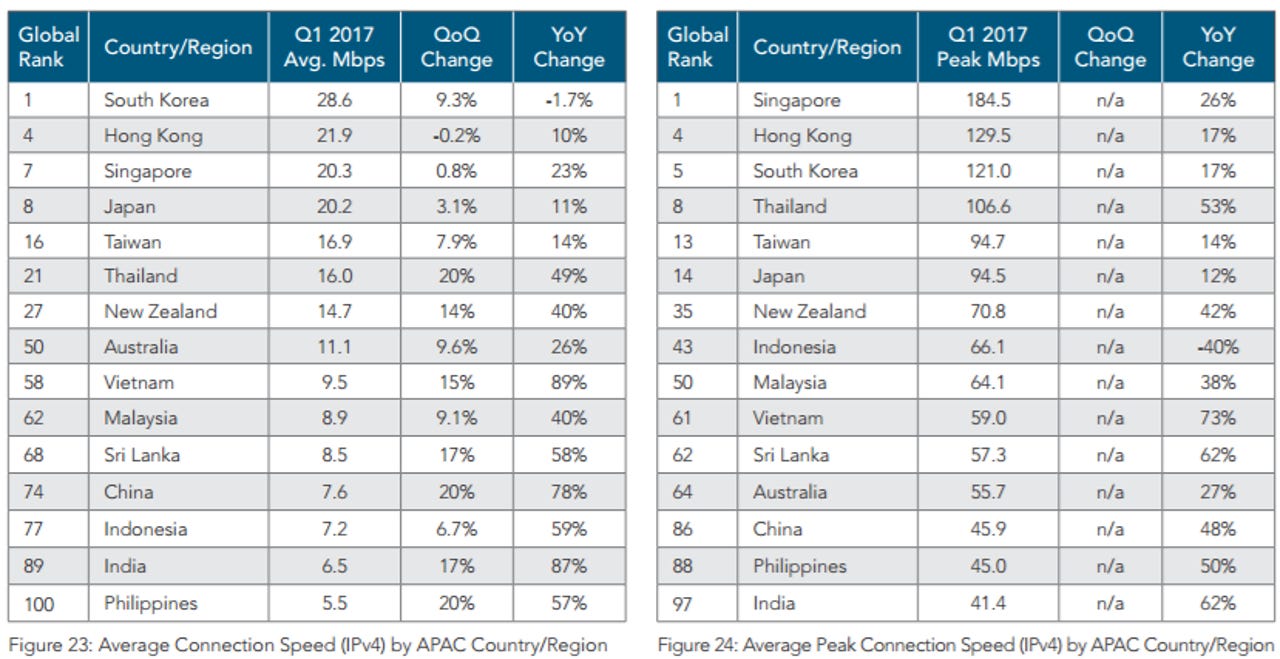Akamai pins Australian peak broadband speeds at 64th globally


Australia is now ranked 64th globally for average peak connection speeds and 50th for average connection speeds across fixed-line broadband, according to Akamai's State of the Internet report [PDF] published overnight.
Average peak connection speeds for Australia were 55.7Mbps in the first quarter of 2017, which was 27 percent faster than last year but more than three times slower than category leader Singapore, which attained 184.5Mbps.
Rounding out the top five regions for the category are Macao, which had average peak connection speeds of 132Mbps; Mongolia, with 131.1Mbps; Hong Kong, with 129.5Mbps; and South Korea, with 121Mbps.
New Zealand ranks 35th and the United States 16th globally, with average peak speeds of 70.8Mbps and 86.5Mbps, respectively.
Australia's 50th-ranking average fixed-line connection speed, meanwhile, was 11.1Mbps, a 26 percent improvement from last year -- but compared to 14.7Mbps in New Zealand.
The frontrunners on average speeds are South Korea, which saw speeds of 28.6Mbps during the quarter; Norway, at 23.5Mbps; Sweden, at 22.5Mbps; Hong Kong, at 21.9Mbps; and Switzerland, at 21.7Mbps.
In the US, which ranked 10th globally to lead the Americas region with an average connection speed of 18.7Mbps, the District of Columbia had the highest average speed of 28.1Mbps, followed by Delaware, Massachusetts, Rhode Island, and Maryland, which all pulled in speeds higher than 20Mbps.
While Australia's National Broadband Network (NBN) has neared its halfway point, with 5 million premises now able to order a service across its 25Mbps minimum speed standard, the nation also ranked poorly in terms of high-speed broadband adoption.
Ranked 47th globally for 15Mbps broadband adoption, just 19 percent of the country had internet of these speeds in the quarter; it was also ranked 50th for 10Mbps broadband adoption, with only 35 percent of the country having access to this, and ranked 61st in adopting broadband of 4Mbps and above, with 81 percent of the country having access to this.
The report made note of NBN's estimate of reaching 5.4 million premises in June -- though it pointed out that NBN "has missed milestones in the past" -- and of the announcement to offer a 100Mbps fixed-wireless product in future, however, which could improve its broadband adoption speed scores.
By comparison, 91 percent of New Zealand's population had access to 4Mbps minimum speeds, 52 percent to 10Mbps, and 32 percent to 15Mbps thanks to its Ultra-Fast Broadband project, which will provide minimum speeds of 100Mbps to 80 percent of the population once rolled out.
Latest Australian news
Mobile connectivity speeds continue to be Australia's saving grace, with its average speeds of 15.7Mbps again ranking highest in the Asia-Pacific region.
Akamai made note of Telstra launching its 1Gbps 4G service in January as partially driving these high speeds.
Telstra's gigabit-speed network was launched with Ericsson in Sydney, Melbourne, and Brisbane, with Adelaide and Perth set to join later this year alongside more areas in future. Telstra at the time also promised to upgrade its standard 4G network to 300Mbps speeds for 80 percent of its footprint by 2019.
Optus similarly switched on a 1Gbps 4.5G network in February with Huawei, although it was only made available at the telco's headquarters in Macquarie Park, Sydney, ahead of being rolled out to 70 percent of Optus' network in Sydney, Melbourne, Adelaide, Brisbane, and Perth during 2017.
Australia's leading APAC mobile speeds were followed closely by Japan, which clocked in at 15.6Mbps on average, and by Taiwan and New Zealand, each with 13Mbps; Indonesia, with 12.8Mbps; and South Korea, with 11.8Mbps.
Globally, Australia's mobile broadband speeds followed only the United Kingdom, which had average speeds of 26Mbps; Cyprus, with 24.2Mbps; Germany, with 24.1Mbps; Switzerland, with 22.4Mbps; Finland, with 21.6Mbps; France, with 17.4Mbps; Norway, with 17.3Mbps; Denmark, with 16.6Mbps; Belgium, with 16.2Mbps; and Romania, with 15.9Mbps.